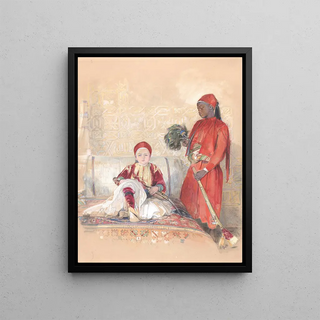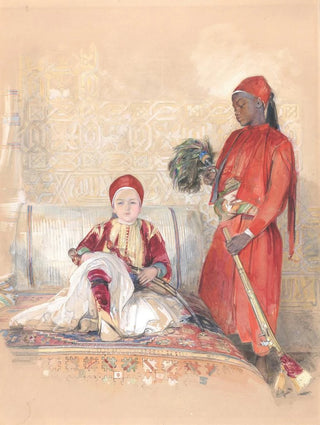Art print | Iskander Bey and his servant - John Frederick Lewis


View from behind

Frame (optional)
In the fascinating world of Orientalist art, the art print "Iskander Bey and his Servant" by John Frederick Lewis stands out for its ability to transport viewers to a world filled with mystery and exoticism. Painted in the 19th century, this canvas depicts a meeting between the East and the West, revealing the subtleties of a rich and complex culture. Lewis, through his mastery of detail and light, manages to capture the very essence of his subjects while offering a romanticized vision of the Orient. The scene depicted invites complete immersion, where each element tells a story, and every exchanged glance between the characters is laden with meaning.
Style and uniqueness of the art print
John Frederick Lewis's style is characterized by meticulous precision and a vibrant color palette that breathes life into his compositions. In "Iskander Bey and his Servant," the artist employs painting techniques that highlight the textures of fabrics and the reflections of light on objects. The rich patterns of the characters' clothing, as well as the architectural details of the setting, testify to thorough research and attentive observation of reality. Lewis does not merely reproduce scenes from daily life; he creates an universe where the viewer can escape, where imagination is free to wander in a world that is both foreign and familiar. The composition, balanced and harmonious, guides the eye through the artwork, gradually revealing the depth of human relationships and the beauty of landscapes.
The artist and his influence
John Frederick Lewis is an artist whose work has marked his era and continues to influence generations of contemporary artists. Born in 1804 in London, he is one of the leading representatives of the Orientalist movement, which experienced significant growth in the 19th century. His passion for the Orient led him to travel to Egypt and Syria, where he drew inspiration for his paintings. Lewis was able to combine elements of his British heritage with Oriental influences, thus creating a unique style that captivated the public of his time. His artistic approach, blending realism and romanticism, paved the way for many artists who have continued to develop this genre.

Matte finish

View from behind

Frame (optional)
In the fascinating world of Orientalist art, the art print "Iskander Bey and his Servant" by John Frederick Lewis stands out for its ability to transport viewers to a world filled with mystery and exoticism. Painted in the 19th century, this canvas depicts a meeting between the East and the West, revealing the subtleties of a rich and complex culture. Lewis, through his mastery of detail and light, manages to capture the very essence of his subjects while offering a romanticized vision of the Orient. The scene depicted invites complete immersion, where each element tells a story, and every exchanged glance between the characters is laden with meaning.
Style and uniqueness of the art print
John Frederick Lewis's style is characterized by meticulous precision and a vibrant color palette that breathes life into his compositions. In "Iskander Bey and his Servant," the artist employs painting techniques that highlight the textures of fabrics and the reflections of light on objects. The rich patterns of the characters' clothing, as well as the architectural details of the setting, testify to thorough research and attentive observation of reality. Lewis does not merely reproduce scenes from daily life; he creates an universe where the viewer can escape, where imagination is free to wander in a world that is both foreign and familiar. The composition, balanced and harmonious, guides the eye through the artwork, gradually revealing the depth of human relationships and the beauty of landscapes.
The artist and his influence
John Frederick Lewis is an artist whose work has marked his era and continues to influence generations of contemporary artists. Born in 1804 in London, he is one of the leading representatives of the Orientalist movement, which experienced significant growth in the 19th century. His passion for the Orient led him to travel to Egypt and Syria, where he drew inspiration for his paintings. Lewis was able to combine elements of his British heritage with Oriental influences, thus creating a unique style that captivated the public of his time. His artistic approach, blending realism and romanticism, paved the way for many artists who have continued to develop this genre.






